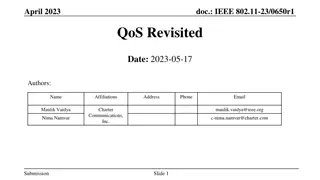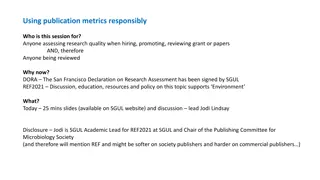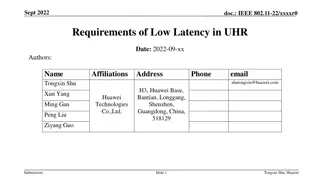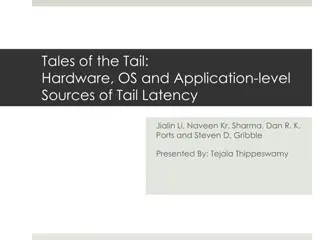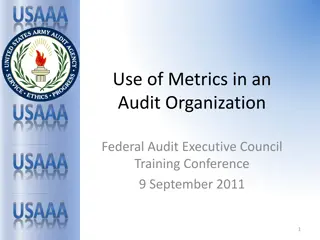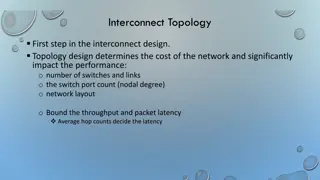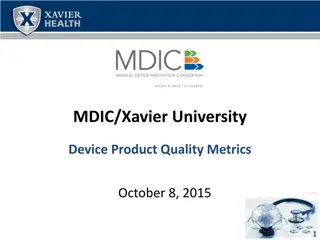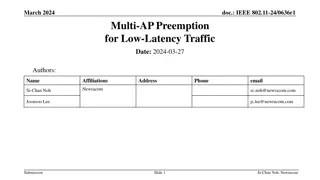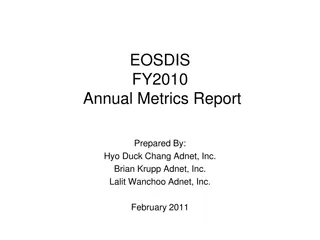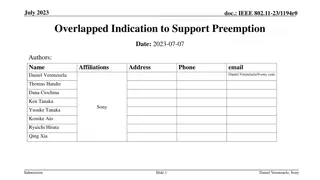Enhancing QoS Facility for Low-Latency High-Throughput Performance in IEEE 802.11 Networks
This proposal addresses the shortcomings in traffic classification and handling of uplink/downlink traffic in current IEEE 802.11 specifications, particularly in relation to low-latency traffic. It also highlights issues with the current EDCA mode in managing congestion and proposes high-level solut
5 views • 18 slides
Understanding Latency in Sentinel-1A Standard Products
The provided information delves into the latency definitions and averages related to ESA Sentinel-1A Standard Products. It covers the different product types, including Extra Wide (EW), Interferometric Wide (IW), and Wave (WV), detailing the average latencies at various stages in data processing. La
5 views • 20 slides
Enhanced Scheduling Method for Low Latency Traffic in IEEE 802.11-24/0091r1
This document presents an enhanced scheduling method for handling low latency traffic in IEEE 802.11 networks. It focuses on supporting deterministic and event-based latency-sensitive traffic, addressing challenges in scheduling and resource allocation. The proposed method aims to improve the reliab
8 views • 12 slides
Enhancing Low Latency Channel Access in Legacy IEEE 802.11 Networks
This document discusses the impact of introducing a Low Latency (LL) channel access mechanism in legacy IEEE 802.11 networks. It addresses the use of High Priority EDCA (HiP EDCA) mechanisms, proposing solutions for improving tail latency in both isolated BSS and multi-BSS scenarios. Additionally, i
2 views • 10 slides
Improving Low-Latency Buffer Status Reporting in IEEE 802.11
Proposal for enhancing the Buffer Status Report (BSR) mechanism in IEEE 802.11 to include timing constraints for transmitting latency-sensitive traffic. Suggestions involve adding TSPEC-based signaling and efficient mechanisms for Enhanced Traffic APs to ascertain low-latency traffic status. The cur
0 views • 12 slides
Understanding Software Testing Metrics and Tools
Software testing metrics play a crucial role in evaluating the quality and progress of the testing process. Metrics provide valuable insights into the readiness, quality, and completeness of a product. By measuring attributes such as defects, testing efficiency, and productivity, organizations can m
3 views • 100 slides
Responsible Use of Publication Metrics in Research Assessment
Explore the responsible usage of publication metrics in research evaluation for hiring, promotion, grants, and papers. The session discusses the flaws of metrics, alternatives, critical analysis, and advocacy supported by DORA and the Leiden manifesto. Learn about the types of metrics used, provider
0 views • 17 slides
Understanding Software Measurement and Metrics in Software Engineering
Software measurement plays a crucial role in assessing the size, quantity, and quality of software products and processes. It involves direct and indirect measurement methods to monitor and improve software quality, predict future outcomes, and manage project budgets and schedules. Software metrics
0 views • 8 slides
Analyzing and Improving Latency in IEEE 802.11 Networks
The document discusses controlling latency in IEEE 802.11 networks to meet the demands of emerging applications that require not only high throughput but also low latency. It covers aspects such as latency analysis, potential improvements, latency vs. reliability trade-offs, and latency improvement
4 views • 14 slides
Evaluation of Low-Latency Services in IEEE 802.11-23/1530r1
This document discusses the evaluation of supported low-latency services in the context of IEEE 802.11-23/1530r1, focusing on the reliability of WLAN, throughput, latency, and MPDU loss. It addresses the challenges in supporting new low-latency services such as AR/VR and industrial IoT, particularly
1 views • 11 slides
Low Latency Requirements in Ultra-High Rate Communication
This document discusses the requirements and use cases of low latency in ultra-high rate communication scenarios, highlighting applications such as metaverse, cloud gaming, real-time video streaming, in-vehicle infotainment, and industrial PLC control. It also covers current methods to reduce latenc
1 views • 12 slides
Understanding Key Dashboard Metrics for Business Management
In today's data-driven world, companies rely on various metrics and tools to make informed decisions and track performance. From HR metrics to manufacturing and finance indicators, this article explores the importance of data in driving business success. Dive into common dashboard metrics, the role
0 views • 18 slides
Understanding Software Process and Project Metrics
Measures, metrics, and indicators play crucial roles in software engineering, providing quantitative insights into product attributes and processes. While measures indicate extent or size, metrics relate individual measures to draw meaningful conclusions. Process metrics track long-term improvements
1 views • 24 slides
Enhancing Web Search Latency with DDS Prediction
This presentation delves into DDS Prediction, a technique designed to reduce extreme tail latency in web search engines by optimizing query execution times and parallelizing specific queries. It addresses the challenges of improving latency for all users and emphasizes the importance of achieving hi
0 views • 31 slides
Understanding Sources of Tail Latency in Hardware, OS, and Applications
Delve into the impact of latency on revenue, with real-world examples from companies like Amazon and Google. Explore the complexities of achieving low tail latency in large-scale applications and the approach to analyzing and mitigating latency sources at hardware, OS, and application levels.
0 views • 24 slides
Analysis of Onion Routing Security and Adversary-based Metrics
In this comprehensive analysis, the security aspects of Onion Routing are scrutinized along with adversary-based metrics. Various security vulnerabilities such as compromised relays and potential attacks on the first and last routers are examined. Existing metrics like entropy coefficients and proba
0 views • 21 slides
Metrics Utilization in Federal Audit Organizations
Utilizing metrics in audit organizations is crucial for performance evaluation and strategic planning. Factors to consider include reliability of data, stakeholder priorities, and providing solutions for organizational challenges. Common metrics such as cost savings, cycle time, client satisfaction,
0 views • 10 slides
Federal Audit Practices and Metrics Evaluation
This content discusses the identification and compilation of internal and external metrics in the Federal audit community, factors in annual audit planning, survey development on internal reporting, external reporting, and annual planning. It also covers objectives of audit practices, feedback recei
3 views • 28 slides
Evaluation Metrics for IEEE 802.11-14/0107 HEW Proposal
Evaluation metrics play a crucial role in assessing WLAN system performance and achieving the objectives of High Efficiency WLAN (HEW). This proposal by Yonggang Fang et al. from ZTE outlines the key evaluation metrics recommended for evaluating HEW performance, including area throughput, average th
0 views • 12 slides
Understanding Interconnect Topology Design and Performance Metrics
Interconnect topology design plays a crucial role in determining the cost and performance of a network. Factors such as the number of switches and links, switch port count, network layout, throughput, packet latency, average hop counts, nodal degree, hop count, and diameter are essential considerati
0 views • 38 slides
Understanding Metrics for Research Impact Assessment
Metrics play a crucial role in assessing the academic impact of research outputs. They provide valuable indicators that need to be interpreted to enhance your research narrative. This overview covers generating, tracking, and measuring metrics with examples of tools and strategies for traditional an
0 views • 22 slides
Architecting DRAM Caches for Low Latency and High Bandwidth
Addressing fundamental latency trade-offs in designing DRAM caches involves considerations such as memory stacking for improved latency and bandwidth, organizing large caches at cache-line granularity to minimize wasted space, and optimizing cache designs to reduce access latency. Challenges include
0 views • 32 slides
Understanding Evaluation Metrics in Machine Learning
Evaluation metrics play a crucial role in assessing the performance of machine learning models. They help quantify how well a model is achieving a specific business objective, guiding efforts to improve performance, and track progress over time. Through metrics like accuracy, precision, recall, and
0 views • 31 slides
Understanding Evaluation Metrics in Machine Learning
Explanation of the importance of metrics in machine learning, focusing on binary classifiers, thresholding, point metrics like accuracy and precision, summary metrics such as AU-ROC and AU-PRC, and the role of metrics in addressing class imbalance and failure scenarios. The content covers training o
0 views • 31 slides
Impact of Latency on Player Performance in Cloud-based Games
Research conducted by Mark Claypool and David Finkel explores the effects of latency on player performance in cloud-based games. The study compares the impact of latency on both objective (performance) and subjective (quality) measures, highlighting how every 100ms increase in latency results in a 2
0 views • 21 slides
Enhancing Low Latency in IEEE 802.11 Networks
Various mechanisms for low latency in IEEE 802.11 networks are discussed, including C-TDMA, C-RTWT, TXOP Preemption, and HiP-EDCA. This proposal aims to improve initial control frame exchanges to prioritize low latency traffic transmission. By modifying exchange rules and allowing STAs to signal the
0 views • 12 slides
MDIC Xavier University Device Product Quality Metrics Team and Goals
This document captures the team members involved in the MDIC Xavier University Device Product Quality Metrics project, highlighting their roles and companies. The purpose and goals of the project include enhancing product quality assurance and enabling resource allocation decisions by identifying pr
0 views • 10 slides
Achieving Bounded Latency in Data Centers: A Comprehensive Study
Data centers face challenges in providing consistent low latencies due to in-network interference and varying workloads. This study explores solutions to guarantee strong latency performance, mitigate latency variance, and minimize performance degradation for latency-sensitive applications. By analy
0 views • 18 slides
Table Layout Guidelines for Data Presentation
Comprehensive guidelines for structuring tables including defining unique records, values of indicators and metrics, age composition, methods documentation, comments, and supporting information. The content outlines the table layouts for values of indicators, metrics, NOSA table indicators and metri
0 views • 26 slides
Understanding Latency Variation in Modern DRAM Chips
This research delves into the complexities of latency variation in modern DRAM chips, highlighting factors such as imperfect manufacturing processes and high standard latencies chosen to boost yield. The study aims to characterize latency variation, optimize DRAM performance, and develop mechanisms
0 views • 37 slides
Latency Measurement in IEEE 802.11 for Low Latency Applications
IEEE 802.11-20/0484r0 discusses the importance of latency measurement for low latency applications in WLAN technologies. The document emphasizes the need for improved worst-case latency and jitter, addressing interference issues to ensure guaranteed latency for scheduled transmissions. Various contr
0 views • 13 slides
Understanding Latency in JESD204B Links
Latency in a JESD204B link refers to the time it takes for a signal to travel from input to output, influenced by factors like system setup, device dependencies, clock propagation delays, and signal alignment. Definitions such as Sample-to-Serial Out (S2SO), Link Delay, and Link Latency are crucial
0 views • 46 slides
Understanding Network Performance Metrics in Telecommunications
This content delves into the realm of network performance measurement in telecommunications, focusing on metrics that impact service quality as perceived by customers. It covers a range of topics including network performance measures, system performance metrics, bandwidth, throughput, latency, erro
0 views • 14 slides
Multi-AP Preemption for Low-Latency Traffic in IEEE 802.11 Networks
Discussion on the necessity of Multi-AP preemption for low-latency traffic in IEEE 802.11 networks. Addresses issues related to latency-sensitive traffic in overlapping basic service sets (OBSS). Proposes a general solution to enable OBSS APs to transmit urgent low-latency traffic without significan
0 views • 9 slides
Metrics and Lessons Learned for Object-Oriented Projects
This chapter discusses various metrics and lessons learned for object-oriented projects, including the use of major OO metrics, Lorenz's metrics, IBM's Object Oriented Technology Council recommendations, and the CK metrics suite. The CK metrics suite covers six OO design and complexity measures, suc
0 views • 17 slides
Considerations for Next Generation Wi-Fi Features Beyond IEEE 802.11be
The document discusses considerations and metrics for the next generation of Wi-Fi beyond IEEE 802.11be, focusing on performance metrics, latency reduction for gaming and interactive video, range extension for wireless video doorbells and surveillance, and market needs for various applications like
0 views • 11 slides
New Queue Mechanism for Real-Time Application Considerations in July 2019
In July 2019, considerations were made for a new queue mechanism for real-time applications. The focus was on improving worst-case latency and jitter for latency-critical traffic, such as in online mobile gaming and manufacturing control. The proposed design aims to link access delay directly to req
0 views • 9 slides
Multi-AP Coordination for Low Latency Traffic Transmission
The document discusses the integration of multi-access point (AP) coordination to enhance the transmission of low-latency traffic in wireless networks. It addresses the challenges and introduces modes of operation capable of reducing latency and improving reliability for low-latency (LL) traffic tra
0 views • 9 slides
EOSDIS FY2010 Annual Metrics Report
The EOSDIS FY2010 Annual Metrics Report provides an overview of data metrics and web activities at the Earth Observation System Data and Information System (EOSDIS) data centers during Fiscal Year 2010. The report includes statistics on data ingest, archive, distribution, and web metrics collected b
0 views • 35 slides
Overlapped Indication for Event-Based Low Latency Traffic Support in IEEE 802.11
The document discusses the importance of reducing latency in Ultra High Rate (UHR) PAR and Event Based Low Latency (LL) traffic support in IEEE 802.11 networks. It introduces the concept of preemption to enhance LL traffic handling and proposes an overlapped LL indication frame to address challenges
0 views • 13 slides
